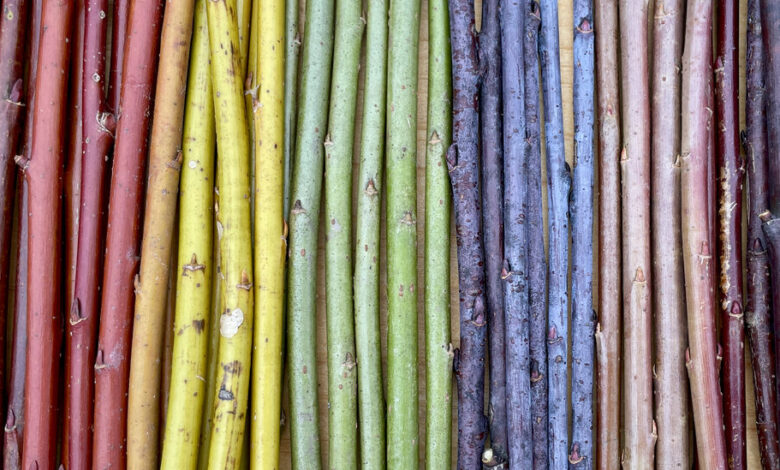Look to Willows to Brighten Your Winter Garden

[ad_1]
Want to create a living fence? Or maybe you’d like to produce bountiful harvests of leaves and twigs to feed livestock, or simply enliven a winter landscape with fiery color?
There’s a willow for that.
Lisa Carper and Aric Vanselous have a willow for all of those purposes, and then some. In their trove of a nursery devoted to the genus Salix, they have several hundred species and varieties from around the world.
But that was hardly the plan. In early 2019, Ms. Carper was browsing online for plants that might work well at the couple’s former New Jersey property.
“We had a little wet patch on our four acres, and it was like, ‘What can we grow there?’” she recalled. “That’s what really got us interested in willows.”
Be careful what you shop for.
On the Vermont Willow Nursery website, she found plenty of possibilities, as well as a notice posted on the homepage: The business was for sale.
Later that year, the couple met the company’s founder, Michael Dodge, a British-born plantsman whose career took him from Royal Botanic Gardens, Kew, in England, to White Flower Farm, in Connecticut, where he was the director of horticulture for 26 years, until 1997. Then came retirement — which, in Mr. Dodge’s case, included creating a willow nursery in 2006 with his wife, Sonia, on about two and a half acres of their 49-acre farm in Fairfield, Vt.
Eventually, they were ready for a second retirement. In the spring of 2020, Ms. Carper and Mr. Vanselous were invited to come help with the harvest — a sort of test drive. By January 2021, it was official: The ownership of the nursery had been transferred to the younger couple.
These days, Ms. Carper, 39, and Mr. Vanselous, 38, are the ones fielding customer inquiries about whether they have the willow for making cricket bats (Salix alba v. caerulea) or, with the growing interest in natural burials, the ones best for weaving coffins.
But Mr. Vanselous needs only to look out the window on a snowy Vermont day and catch a glimpse of, say, the Salix fragilis selection Flame Yellow to know what will strike gardeners as even more useful, especially in winter.
Willows are good at making us gasp.
“It’s just a brilliant yellow against an entire white environment,” he said. “I never knew that such trees even existed; I didn’t know such colors were possible in trees.”
They are possible, in certain willow species, provided you prune to promote ongoing production of fresh shoots. The techniques used were developed as far back as the Stone Age to manage trees and woodlots as renewable resources.
Willows are coppiced — cut regularly to within an inch or two of the base to flush fresh growth — or pollarded, with cuts made higher up on the trunk or branches. Pollarding was originally intended to protect new shoots from browsing by wildlife, but gardeners have capitalized on the ornamental potential of both techniques.
Willow bark is most colorful in the first two or three years after such hard pruning, but many gardeners make it an annual practice. Either way, your cuts should be done between late fall, after the leaves drop, and late winter, before new growth begins.
The payoff could maximize the bright red to deep red-purple of the violet willow (S. daphnoides) or the reddish-purple of the sharp-leaf willow (S. acutifolia).
Among the most sought-after willows for their twig color, Ms. Carper said, are the vivid red, yellow and orange cultivars from the species S. fragilis, including one called Britzensis — the exceptional coral bark willow that is a beacon in winter.
Colorful Catkins Bring in the Pollinators
At this time of year, stretches of warmer days coax open a cascade of willows’ fuzzy catkins, putting another Salix strength on display.
“If you have a nice burst of catkins just blooming at the same time, there’s truly a buzzing,” Ms. Carper said. “Like with fruit trees — these are the same way. That’s a really great feeling.”
Mr. Vanselous’s assessment: “Pollinator assistance.”
Salix are generally dioecious — their male and female reproductive parts are on different plants. Both male and female catkins offer nectar, but only the males produce pollen, and they are generally showier. (You’ll know if you’ve brushed against a male, Ms. Carper said, from the telltale marks she calls “pollen kisses.”)
Probably the best-known catkin show-off — beloved by bees, gardeners and flower arrangers — is the Japanese pink pussy willow Mt. Aso, a variety of Salix gracilistyla. Also dramatic: the black pussy willow (S. gracilistyla Melanostachys).
The gleaming yellow Balfour willow (S. x balfourii) is another star, and selections of the goat willow (S. caprea) “pack a lot of catkins on a small amount of stem,” Mr. Vanselous said.
The earliest catkins, and among the largest — which sometimes appear in January at the nursery — are from the giant pussy willow, a S. leucopithecia hybrid named Winter Glory (formerly S. chaenomeloides). Another hybrid from the same parentage, Rabbit’s Foot, has even bigger, fluffier gray catkins.
How we prune has consequences here, too. To generate more catkins, you need to coppice or pollard, Mr. Vanselous said, because “when you do that, it stimulates growth where you cut, which stimulates more catkin growth, because catkins only appear on last year’s growth.”
One means serves two ends, both form and function.
“The cross section between artistry and bringing animals like the pollinators to your yard is pretty closely intertwined,” he said.
And all those trimmings? Root them to make more plants to share — or maybe create living willow structures like tunnels, domes and fedges. (A fedge? That’s a cross between a fence and a hedge.)
A Tunnel, a Fedge or Simply a Showy Shrub
If you scan the Vermont Willow Nursery site, you won’t find any potted plants.
The nursery sells cuttings in various lengths, prepared from each spring and fall harvest, including bundles of rods for making structures. The prepackaged structure kits come with eight-foot rods and rubber ties used to hold the twigs in desired positions or to attach them to supports.
The purple osier (S. purpurea) and selections of the Japanese species S. miyabeana are particularly well adapted to making structures, and purpurea has an advantage: It tends to be unpalatable to deer.
Willows contain natural hormones that make their cuttings easy to root if you meet their basic needs: a spot in the sun and attention to regular watering, especially in the months after planting.
To discourage weed competition, lay down landscape fabric or heavy plastic sheeting over the footprint of your project before planting, removing it once the plants establish themselves. Poke a hole through the weed barrier into the soil, so that about the bottom foot of each willow rod will fit snugly inside. A piece of rebar will do for digging, rather than a shovel.
Important: Willow rods (or shorter cuttings for other uses) must be planted so the buds face up, as they did before harvest. They won’t root upside down.
A structure may require pruning more than once a season, Ms. Carper said, which could feel like a chore — “or that could be amazing, if you have animals you were trying to feed.” Including rabbits.
Rabbit feed has gotten expensive, so lately people have been asking if there’s a willow stand-in. The best choice for producing bountiful biomass, whether for the bunnies or as biofuel in the wood stove: the Salix miyabeana variety Sx61.
Twigs and catkins aren’t the only sought-after ornamental features willows offer. Many have outstanding foliage, including the dappled willow Hakuro Nishiki, which has white-splashed foliage with hints of pink. Its close cousin, Flamingo, has extra pink.
The native shining willow (S. lucida) bears lustrous leaves with serrated edges. The foliage of another native, the bayberry or blueleaf willow (S. myricoides, especially the variety Bronze Beauty), is reddish bronze when fresh. If gold appeals to you, try the S. fragilis type called Aurea, with its chartreuse leaves and yellow stems.
Others are just attention-grabbing oddballs, like Golden Curls, a corkscrew willow with twisted yellow stems. And none is more unusual than the Japanese fantail or fishtail willow (S. udensis Sekka), which the nursery owners call “something straight out of a Dr. Seuss book.” Its stems are curiously inclined, by a benign malformation known as fasciation, to twist and flatten into a fantail shape. Dried fantails make a fun addition to flower arrangements.
Five years ago, Ms. Carper and Mr. Vanselous weren’t on a first-name basis with these plants, and if not for that wet spot in their New Jersey backyard, they might not have started down the willow path.
As it happens, water is sort of a theme for them, so maybe it fits that they are now caretakers of a collection of Salix, which generally like soil with at least even moisture.
For more than 15 years, Ms. Carper and Mr. Vanselous both worked in the Water Resources Mission Area of the United States Geological Survey, where she remains a hydrologist. In those jobs, they witnessed willows’ impressive role in stream-bank restoration and erosion control.
Yes, there are willows for those purposes, too, and the nursery’s business plan calls for increasing the plantings of appropriate species to serve larger-scale clients undertaking environmental restoration projects.
As Mr. Vanselous said, “That one hits home for us.”
Margaret Roach is the creator of the website and podcast A Way to Garden, and a book of the same name.
For weekly email updates on residential real estate news, sign up here.
[ad_2]
Source link






